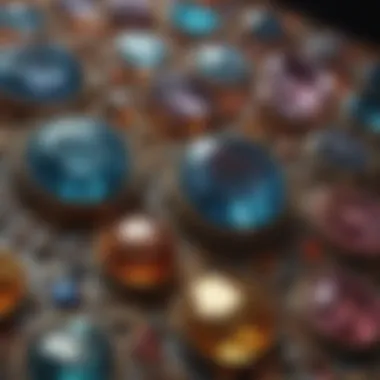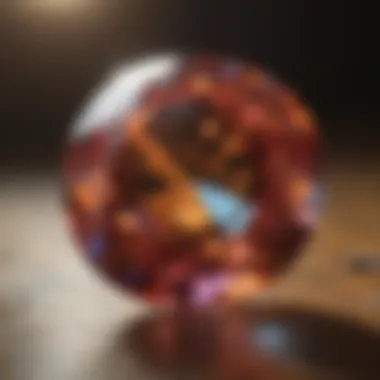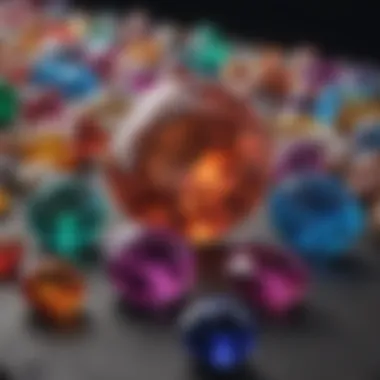Unveiling the Fascinating Art of Polished Gemstone Identification


Gemstone Identification Techniques
The art of identifying polished gemstones is a meticulous process that marries scientific analysis with artistic appreciation. Enthusiasts and collectors alike embark on a journey filled with intriguing insights and innovative techniques to distinguish and admire the unique characteristics inherent in each gemstone.
Analyzing Polished Gemstones
When examining polished gemstones, attention to detail is paramount. Some crucial aspects to consider include color, clarity, cut, and carat weight. A keen eye for observing inclusions and flaws becomes indispensable in determining the authenticity and quality of the gemstone under scrutiny.
Gemological Tools and Equipment
Equipping oneself with the right tools is fundamental in mastering the art of polished gemstone identification. Instruments such as a refractometer, spectroscope, and loupe aid in assessing a gemstone's optical properties, aiding in the identification process. Additionally, advanced equipment like spectrometers and microscopes provide in-depth analysis for the most discerning gemologists.
The Science Behind Gemstones
Diving into the scientific realm of gemology unveils a world of mineral compositions, crystal structures, and formation processes. Understanding the geological origins and metamorphic journeys of gemstones adds a layer of intrigue to the identification process, enriching the collector's knowledge and appreciation for these natural wonders.
Understanding the Fascinating World of Polished Gemstones
Exploring the Allure of Polished Gemstones
The Evolution of Polishing Techniques
Delving into The Evolution of Polishing Techniques unveils a rich tapestry of history and innovation. Here, we unravel the specific methodologies and tools that have shaped the art of gemstone polishing over centuries. Understanding the evolution of these techniques provides invaluable insights into the craftsmanship and dedication required to achieve flawless gemstones. The meticulous nature of traditional techniques contrasts with modern advancements, accentuating the need for precision and expertise in enhancing gemstone aesthetics.
The Significance of Luster and Reflections
Embarking on The Significance of Luster and Reflections leads us into a realm where light and composition converge to mesmerize the beholder. Exploring the play of light on polished surfaces unveils the intrinsic beauty hidden within gemstones. The nuances of luster and reflections accentuate the quality and authenticity of a gem, serving as indicators of its rarity and allure. Dive into the enigmatic world of luster and reflections to decipher the stories whispered by each gleaming facet, a journey reserved for connoisseurs seeking the true essence of polished gemstones.
The Artistry of Gemstone Polishing
The Role of Precision and Skill
Unveiling The Role of Precision and Skill delves into the artistry and expertise required to elevate raw gemstones into exquisite works of art. Precision forms the bedrock on which gemstone polishing stands, demanding an unwavering attention to detail and profound understanding of materials. Skillful hands craft each gem with care and mastery, breathing life into inert stones and unfurling their hidden beauty. The fusion of precision and skill encapsulates the essence of gemstone polishing, creating transcendent pieces that mesmerize and captivate the discerning eye.
Enhancing the Intrinsic Beauty of Gemstones


Exploring Enhancing the Intrinsic Beauty of Gemstones unravels the delicate balance between preservation and enhancement. The artistry lies in accentuating the natural allure of gemstones without overshadowing their inherent charm. A meticulous process that requires a keen eye for subtlety, enhancing the intrinsic beauty of gemstones involves unveiling their unique features while retaining their authenticity. Dive into this realm of artistry to witness how skilled hands can transform raw gemstones into captivating treasures that stand the test of time.
Key Factors in Identifying Polished Gemstones
Identifying polished gemstones is a crucial aspect in the realm of gemology, where enthusiasts and collectors strive to distinguish and appreciate the unique qualities of these precious stones. Understanding the key factors that play a role in this identification process is fundamental to this article's exploration. Factors such as color, texture, shape, and cut characteristics are essential in determining the value and authenticity of gemstones. By delving into these elements, one can unravel the intricate world of gemstone identification and gain a deeper appreciation for the art and science behind it.
Color and Hue Distinctions
In the domain of polished gemstones, color and hue distinctions hold paramount importance. Analyzing factors like vibrancy and clarity is crucial in assessing the quality and rarity of a gemstone. The brilliance and intensity of color can significantly enhance the visual appeal of a gemstone, making it a sought-after choice among collectors. On the other hand, interpreting subtle color variations allows enthusiasts to recognize the unique characteristics of each gemstone, contributing to their overall value and allure. Understanding these nuances adds depth to the identification process and enriches one's experience in the world of gemstones.
Analyzing Vibrancy and Clarity
Analyzing the vibrancy and clarity of a gemstone involves assessing the purity and saturation of its color. Vibrant colors with high clarity are often indicative of a valuable and pristine gemstone. This aspect plays a pivotal role in determining the aesthetic appeal and market value of gemstones, making it a fundamental consideration for collectors and enthusiasts alike.
Interpreting Subtle Color Variations
Interpreting subtle color variations requires a keen eye for detail and an understanding of the intricacies of gemstone hues. Identifying these subtle shifts in color can reveal important information about the gemstone's quality and origin. While subtle variations add character and charm to a gemstone, they can also impact its overall value and desirability in the market.
Texture and Refractive Indices
Texture and refractive indices are key factors in assessing the quality and authenticity of polished gemstones. Differentiating surface textures allows experts to determine the craftsmanship involved in polishing the gemstone. Evaluating light dispersion effects provides insights into the gemstone's optical properties and how it interacts with light sources, enhancing its overall brilliance and appeal.
Differentiating Surface Textures
The ability to differentiate surface textures is essential in recognizing the level of craftsmanship applied to a polished gemstone. A smooth and uniform texture indicates skilled polishing techniques, while irregular textures may suggest flaws or imperfections in the gemstone. Understanding surface textures is crucial in identifying high-quality gemstones and appreciating the effort put into their creation.
Evaluating Light Dispersion Effects
Evaluating light dispersion effects involves observing how light interacts with the gemstone's surface and interior. Gemstones with high light dispersion exhibit exceptional brilliance and fire, captivating the beholder with their spectral hues. By comprehending these effects, collectors can assess the optical purity of gemstones and discern their value in the competitive gem market.
Shape and Cut Characteristics
The shape and cut of a gemstone play a significant role in its appeal and value. The influence of faceting styles on a gemstone's appearance highlights the craftsmanship and precision required to enhance its beauty. Recognizing unique gemstone cuts allows enthusiasts to appreciate the creativity and individuality expressed in each stone, adding a layer of intrigue to the gemstone identification process.
The Influence of Faceting Styles
Faceting styles have a profound impact on the brilliance and visual appeal of a gemstone. Different facets interact with light in varying ways, creating mesmerizing patterns and reflections that enhance the stone's beauty. Understanding the influence of faceting styles enables enthusiasts to discern the intricacies of gemstone cutting techniques and develop a keen eye for evaluating cut quality.


Recognizing Unique Gemstone Cuts
Recognizing unique gemstone cuts requires a blend of artistry and technical knowledge. Distinctive cuts such as emerald, princess, or marquise showcase the skill and creativity of gem cutters, resulting in one-of-a-kind pieces coveted by collectors. By recognizing these unique cuts, enthusiasts can expand their understanding of the diverse world of gemstones and appreciate the heritage and craftsmanship behind each exquisite creation.
Advanced Techniques for Gemstone Identification
The section on advanced techniques for gemstone identification delves into crucial methodologies that play a significant role in distinguishing polished gemstones. Understanding these advanced techniques is paramount for enthusiasts and collectors seeking to uncover the intricacies of gem identification. By employing sophisticated methods like spectroscopy and microscopy, individuals can gain deeper insights into the gemstones they encounter. These techniques not only enhance the accuracy of identification but also open up a realm of scientific analysis that adds a layer of sophistication to the process. The utilization of advanced techniques elevates gemstone identification from a mere visual inspection to a detailed scientific exploration, offering a comprehensive understanding of each unique gemstone's composition and properties.
Utilizing Spectroscopy and Microscopy
Insights from Spectral Analysis
The insights derived from spectral analysis provide a wealth of information regarding the composition and characteristics of polished gemstones. Spectral analysis offers a detailed look at the spectrum of light absorbed and emitted by a gemstone, helping in identifying trace elements and potential treatments that may affect its value. This method is highly valuable in identifying synthetic gemstones or detecting enhancements that may not be visible to the naked eye. One of the key advantages of spectral analysis is its precision, allowing for accurate classification of gemstones based on their spectral fingerprints. While spectral analysis is incredibly informative, it requires specialized equipment and expertise, making it imperative for gemstone enthusiasts to rely on skilled professionals for thorough analysis.
Microscopic Examination Methods
Microscopic examination methods provide a close-up view of polished gemstones, revealing intricate details that are invisible to the naked eye. Through high-resolution magnification, gemstone enthusiasts can observe internal features, inclusions, and structural characteristics that aid in identification and authentication. This method is particularly useful in differentiating natural gemstones from synthetics or identifying specific growth patterns that hint at the gemstone's origin. The advantage of microscopic examination lies in its ability to uncover subtleties that contribute to a gemstone's uniqueness, offering enthusiasts a deeper appreciation for the craftsmanship and natural processes behind each polished gemstone. However, proper training and a discerning eye are essential for effectively interpreting the findings of microscopic examination methods.
Testing for Hardness and Clarity
Mohs Scale of Hardness
The Mohs scale of hardness serves as a fundamental tool in gemstone identification, allowing enthusiasts to assess the relative hardness of different gemstones. By performing simple scratch tests using minerals of known hardness, individuals can determine the hardness level of a gemstone, aiding in its classification and potential applications. The Mohs scale provides a standardized measure that helps in differentiating between softer and harder gemstones, guiding collectors in their handling and care practices. While the Mohs scale offers a quick and practical method for evaluating hardness, it is essential to note that this scale has limitations when dealing with delicate or complex gemstone compositions.
Determining Optical Purity
Determining the optical purity of a gemstone involves assessing its clarity and transparency, aspects that significantly impact its visual appeal and value. Gemstone enthusiasts utilize various methods, including refractometers and polariscopes, to measure light transmission and identify any optical anomalies within a gemstone. By analyzing optical purity, collectors can make informed decisions regarding a gemstone's quality and authenticity, distinguishing natural gemstones from synthetics or treatments. This approach is critical for assessing the overall beauty and value of a polished gemstone, guiding enthusiasts in appreciating the clarity and brilliance that contribute to its allure. However, interpreting optical purity requires a keen eye and an understanding of the factors that influence a gemstone's optical properties, emphasizing the importance of both technical knowledge and practical experience in gemstone evaluation.
Practical Tips for Gemstone Enthusiasts
In the realm of polished gemstone identification, practical tips hold significant value for enthusiasts aiming to deepen their understanding and appreciation of these exquisite creations of nature. These tips serve as guiding beacons amidst the vast sea of information surrounding gemstones, offering a structured approach to learning and exploring their nuances.
Enthusiasts benefit greatly from embracing practical tips as they embark on their journey of gemstone discovery. By integrating these tips into their endeavors, collectors can streamline their learning process, enhance their ability to differentiate between various gemstone types, and develop a keen eye for recognizing key attributes that define each specimen. Furthermore, practical tips empower enthusiasts to make informed decisions when adding new pieces to their collection, ensuring each acquisition aligns with their personal preferences and collection goals.
The significance of building a reference collection in the context of gemstone enthusiasts lies in its role as a cornerstone for learning and growth. Establishing a comprehensive reference collection allows enthusiasts to compare and contrast various gemstones, facilitating a deeper understanding of their unique characteristics, such as color, clarity, and refractive indices. Through systematic observation and analysis of diverse specimens, collectors can refine their knowledge base, honing their skills in gemstone identification and appreciation.


The Value of Comparative Analysis
A pivotal aspect of building a reference collection, comparative analysis enables enthusiasts to draw connections between different gemstones, identifying similarities and differences that shape each stone's individuality. By juxtaposing various specimens side by side, collectors can discern subtle variations in color saturation, transparency, and brilliance, aiding them in establishing a discerning eye for quality and authenticity. This meticulous comparative approach not only enhances gemstone identification competence but also fosters a deeper appreciation for the intricate beauty inherent in each polished gemstone.
Documenting Gemstone Attributes
Documenting gemstone attributes plays a vital role in cataloging and preserving valuable information about each specimen within a collection. Through detailed documentation of key characteristics such as weight, dimensions, inclusions, and provenance, enthusiasts create a comprehensive record that serves as a reference guide for future evaluations and acquisitions. This meticulous documentation not only ensures the integrity of a collection but also provides valuable insights into the provenance and history of each gemstone, enriching the overall collecting experience.
Engaging with the Gemstone Community
Active engagement within the gemstone community cultivates a vibrant exchange of knowledge, experiences, and insights among enthusiasts, fostering a sense of camaraderie and shared passion for these captivating treasures of the earth. By participating in gem shows and events, collectors gain access to a diverse array of gemstone specimens, expert opinions, and industry trends, expanding their horizons and forging valuable connections within the community.
Attending Gem Shows and Events
Attending gem shows and events provides enthusiasts with a unique opportunity to immerse themselves in the world of gemstones, exploring rare and exotic varieties, interacting with seasoned professionals, and discovering the latest innovations in gemstone cutting and design. These events offer a sensory feast for gemstone aficionados, allowing them to witness firsthand the beauty and diversity of gemstones from around the globe, inspiring them to deepen their knowledge and passion for these mesmerizing creations.
Networking with Fellow Enthusiasts
Networking with fellow enthusiasts fosters a dynamic environment for knowledge sharing and collaboration within the gemstone community. By connecting with like-minded individuals who share a mutual appreciation for gemstones, collectors can engage in insightful discussions, trade experiences, and seek advice on various aspects of gemstone identification and collection. This sense of community not only enhances the passion and enthusiasm of collectors but also cultivates a supportive network that enriches the overall gemstone collecting journey.
Embracing the Journey of Gemstone Identification
In this article, the section "Embracing the Journey of Gemstone Identification" plays a crucial role in guiding enthusiasts and collectors through the intricate world of polished gemstone identification. It emphasizes the significance of developing a keen eye for detail and understanding the characteristics that make each gemstone unique. By delving into this topic, readers can enhance their appreciation for the art and science behind gemstone identification, ultimately enriching their collecting experience.
Cultivating a Discerning Eye
Enhancing Observation Skills:
The aspect of enhancing observation skills is paramount in the realm of gemstone identification. By honing this ability, enthusiasts can notice subtle nuances in color, texture, and structure that are essential for differentiating between gemstone varieties. Such keen observation allows for a deeper understanding of the gemstone's quality and origin, enabling collectors to make informed decisions regarding their acquisitions. The attention to detail required in enhancing observation skills is highly valued in this article as it forms the foundation for accurate gemstone identification.
Developing a Personal Aesthetic:
Developing a personal aesthetic in gemstone appreciation is a pivotal aspect of the journey of identification. It involves creating a unique sense of style and preference when selecting gemstones based on their appearance, color, and cut. This personal touch adds depth to the collector's experience, showcasing their individual taste and aesthetic sensibilities. While subjective, a personal aesthetic enhances the emotional connection to gemstones and transforms the act of collecting into a personal expression of art and beauty.
Appreciating the Diversity of Gemstones
Exploring Rare and Exotic Varieties:
Exploring rare and exotic gemstone varieties opens up a world of possibilities for collectors. These unique gemstones, often scarce and prized for their distinct characteristics, offer a glimpse into the rich diversity of the Earth's mineral treasures. By venturing into this realm of exclusivity, collectors can broaden their knowledge and collection, adding valuable specimens that set them apart in the gemstone community. The allure of rare and exotic gemstones underscores the exceptional journey of gemstone identification.
Understanding Geological Origins:
Understanding the geological origins of gemstones provides a scientific and historical context to their existence. It delves into the formation processes, mineral compositions, and environmental factors that contribute to the creation of each gemstone type. This knowledge not only enhances the collector's understanding of gemstones but also fosters a deeper appreciation for the Earth's geological wonders. By unraveling the geological origins of gemstones, collectors can grasp the intricate links between nature, time, and the beauty found within the depths of the Earth.







